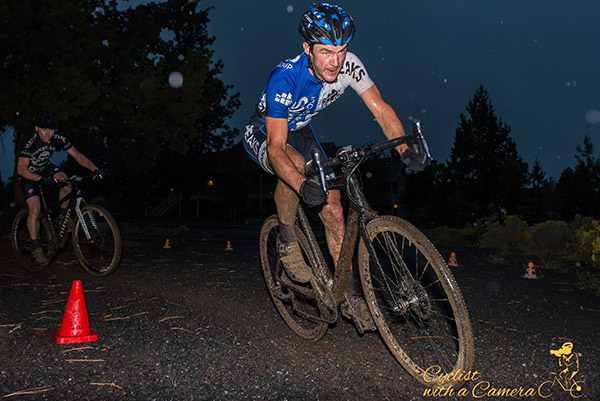By Brig Brandt, PCG Elite Coach
If you’re a mountain biker, you are very likely to race in the mud if you haven’t already, which can mean equipment failures and cold race conditions. And as this year’s Dirty Kanza proved, mud isn’t just limited to fat tire escapades.
Click through for three key tips to help minimize the common pitfalls racers may encounter during their spring racing campaign…
Know your conditions
If you’re planning to race in an area that’s far away or has different weather patterns from what you’re used to, make sure to contact a local shop (or race promoter) for current and race day trail conditions. If it has been or will be raining, try to get an idea of the soil conditions. Clay-based soils tend to build up on tires, pedals, and every other critical bike part. Rockier soils tend to drain well, so racing in the rain will most likely just be wet.
Tweak your equipment
For a key race in muddy conditions, I like to make a few equipment changes.
Tires: Skinnier mountain bike tires with tall, widely spaced knobs offer more clearance for sticky mud. They roll slowly and will offer poor traction in most other conditions, though, so don’t leave them on post race.
Fender: Yes, I know, it’s a bike race, not a commute to the movies. But front fenders keep mud from flying into your face, glasses, and eyes, which means you’ll be able to see, and being able to see means riding faster! In a pinch a tall water bottle can be zip-tied to the down tube. Another neat trick is to cut an inner tube and then stretch and zip tie it from the fork’s crown to it’s arch. This will keep mud from flinging forward into your path, which has an uncanny way of finding your eyes.
Brake pads: For disc brakes I like to switch from an organic pad to a metallic pad. It’s possible to wear out a set of organic pads in a single muddy race. Metallic pads offer better braking power in poor conditions and will last significantly longer. The down side? Metallic pads can howl, so be ready for noise.
Cables and housing: While offering a little more friction than new, clean cables, a solid housing from shifter to derailleur will offer better shifting performance on longer wet races. Remember, a drivetrain is compromised in muddy conditions. Shifting under load is a bad idea unless you want to risk a broken chain, chain suck, or other common “mud mechanicals” like a completely wrecked rear derailleur.
Replacement derailleur hanger: No, it’s not really an equipment choice, but always have one in your race bag, especially for multi-day mountain bike races or cross weekends. This is probably the smallest, cheapest, and easiest to carry part that you will never find when you need it.
Chain lube: Leave your dad’s WD-40 at home and throw a wet lube in your bag. Wet lubes are messy and will attract more dirt and grime than a dry lube (which means don’t use them in dry, dusty conditions), but they stay on longer when it’s nasty out. I’ve had great luck with Gnar Lube’s Blue Opal lube.
Pick your clothing wisely
Picking the right clothing for wet racing is tricky. Remember, you’ll produce significantly more heat when racing than when training, so I prefer the “less is more” adage. If it’s wet I tend to use an embrocation or petroleum based oil to repel water instead of arm or leg warmers. In my experience, more clothing often means more wet clothing, which gets heavy in a hurry. Clothing is very personal, however; I know a seasoned pro who knowingly starts races overdressed because he hates being cold. Before deciding what to wear, consider the terrain, time of day, race length, remoteness, etc. Always err on the side of caution. Always.
Speaking of caution, even if you’re not usually one to wear eye protection (i.e. sunglasses) while riding, a good set of clear or yellow lenses will keep the inevitable mud and spray from blinding you.
Remember, mechanicals are more likely to occur in muddy conditions. A little bit of clothing and equipment preparation will help minimize some common muddy racing dilemmas and give you a leg up on your competition. Have fun and enjoy the slop; the dusty season is just around the corner!
Want more expert advice? Learn more about our coaching services and training plans at our website.
 Brig Brandt is a USA Cycling Level 2 and power certified coach who earned the USA Cycling “with distinction” award for his ongoing commitment to continuing education. He has had the pleasure of coaching masters and professional athletes to multiple national championship podiums and believes that any athlete, even one with limited time, can see significant improvement with focused training. He and our other coaches create custom training plans for all levels of athletes. Brig can be contacted directly through peakscoachinggroup.com or via email at info@peakscoachinggroup.com.
Brig Brandt is a USA Cycling Level 2 and power certified coach who earned the USA Cycling “with distinction” award for his ongoing commitment to continuing education. He has had the pleasure of coaching masters and professional athletes to multiple national championship podiums and believes that any athlete, even one with limited time, can see significant improvement with focused training. He and our other coaches create custom training plans for all levels of athletes. Brig can be contacted directly through peakscoachinggroup.com or via email at info@peakscoachinggroup.com.
Photo credit: Tim Schallberger – Cyclist with a Camera
